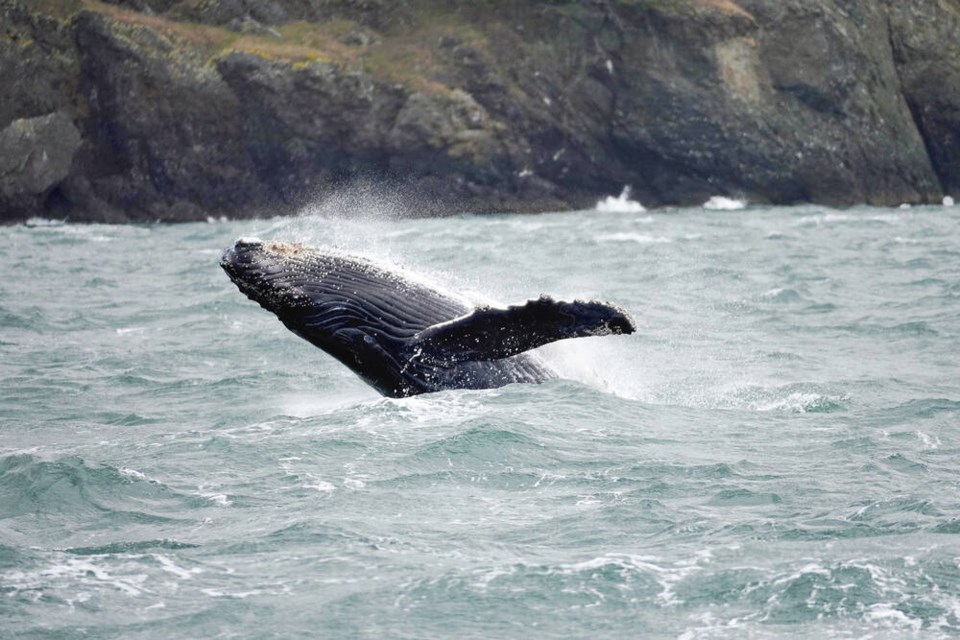A humpback whale involved in a dramatic disentanglement off Texada Island nearly two years ago has returned to the Salish Sea again this year — this time with her first calf.
The confirmation of the humpback calf came as a pleasant surprise to scientists and rescuers, but with the grim reminder that entanglements are continuing all along the B.C. coast — some reported and many not — as humpbacks make a comeback from near extinction.
“A new calf from a whale we helped … it’s just awesome news,” said Paul Cottrell, head of Fisheries and Oceans Canada’s Marine Mammal Rescue unit. “It just makes all that hard work and dedication from our team all so worthwhile. It’s a good feeling that we were able to save this whale.”
BCY 0946, also known as Slits, was tangled in steel rope and dragging a float and prawn-fishing gear when Cottrell got the call in late October 2022 from Western Prince Whale Watching in the Strait of Georgia.
Cottrell and other DFO boats were able to track the whale’s movements after fisheries officers put a satellite tag on the trailing gear.
Cottrell’s team found Slits and launched a drone that showed the 10-metre-long whale had a steel rope wrapped through its mouth. The animal was tiring after dragging the heavy gear and damaging its mouth. The rescue was further complicated by Slits travelling with companion whales swimming close by.
Cuts were made on the steel rope to create a tension, which caused the whale to “spy hop and flip,” releasing the animal.
“It was very tricky, but such a relief when it all let go,” said Cottrell.
Slits, who is believed to be 13 years old, was photographed with her new calf on June 4 on the west side of San Juan Island by Michael Kurbatoff of Prince of Whales whale watching, and this week near Nanaimo by another whale-watching company.
Until the sightings with the calf, it wasn’t known whether Slits was a male or female, and it still isn’t known where she spends her winters. Humpbacks in the Salish Sea usually go to either Hawaii or Mexico to calve, and migrate back to feed from spring to summer.
In 2022, 396 individual humpbacks were documented in the waters around Vancouver Island, an increase from the 293 humpbacks recorded in the same area five years ago and the highest number in a single year since record-keeping started more than two decades ago, according to the Humpback Whales of the Salish Sea Project.
The whales were hunted to near extinction during the last century and are under pressure now from climate change, as well as ship strikes and entanglements.
Jackie Hildering of the Marine Education and Research Society said Slits was first documented in 2011 as a sub-adult and has been returning every year.
Since she was released from the fishing gear, Slits was sighted more than 20 times last year, according to data from the Canadian Pacific Humpback Collaboration, which is co-ordinated by MERS and identifies each individual whale.
While the outcome for Slits was positive, it’s so important to realize how many humpbacks who are entangled are never documented, let alone rescued, said Hildering.
She said MERS research, in collaboration with Fisheries and Oceans Canada, has found that an estimated 50% of humpbacks have scarring from being entangled at least once in their lives.
“This does not account for those who have died from entanglement and have sunk to the ocean bottom or who have washed up somewhere where they are never detected,” said Hildering.
Cottrell said DFO has already had eight reports of whales tangled in fishing gear this spring. Last week, he was called to Tofino for a report of a humpback calf wrapped in fishing gear, but could not locate the whale.
Hildering said it can be tempting to think that all whales that are entangled will be seen and rescued, “but this will never be the case in B.C.’s vast waters.”
“More boater education is needed, more resources are needed for disentanglement and to understand where and how entanglements are happening to be able to reduce the risk at the source,” she said.
Cottrell said boaters are often the only way that DFO is notified about entanglements. He said DFO’s Incident Reporting Line (1-800-465-4336) “is a major part of the team effort we put in to help these whales.”
Erin Gless of the Pacific Whale Watch Association, which has about 30 member companies in the U.S and Canada, said the industry plays a major role in keeping eyes on orcas and other whales. She said whale-watching members were able to report both the entanglement and the birth of the humpback’s first calf.
“These are the types of updates that truly make our efforts as professional whale watchers worthwhile,” said Gless. “If we hadn’t been on the water that day to report the entanglement, and DFO hadn’t been able to intervene, it’s hard to say what the outcome would have been.
“Slits might not be with us anymore, and we might not have this new calf in the population.”
>>> To comment on this article, write a letter to the editor: [email protected]



